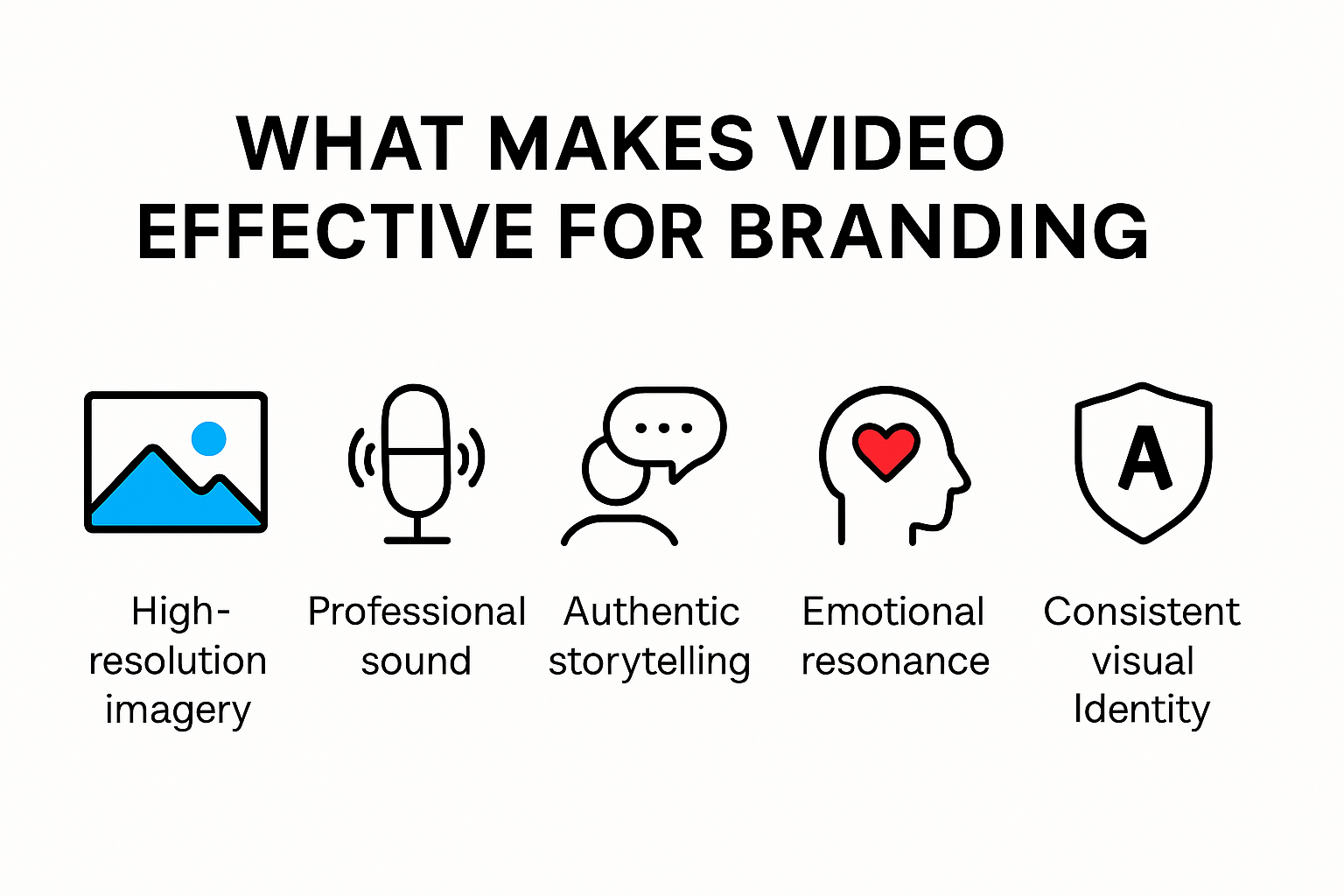Understanding the Role of Video in Corporate Branding
- Pieter Nijssen
- Aug 22
- 7 min read
Most people think corporate branding is just about a sharp logo or catchy tagline. But check this out. Consistent branding can increase revenue by up to 23 percent according to recent studies. That flips the old thinking on its head because it shows real success comes from building a powerful story and emotional connection, not just a pretty design.

Table of Contents
Quick Summary
Takeaway | Explanation |
Corporate branding shapes perceptions. | It defines how stakeholders view an organization through consistent messaging and visuals. |
Video enhances emotional connection. | Utilizing video captures attention and facilitates deeper engagement through storytelling. |
Quality production is crucial for branding. | High production standards reflect professionalism and enhance message perception. |
Authentic narratives create lasting impressions. | Videos should focus on relatable human experiences to foster emotional bonds. |
Community-driven content boosts brand loyalty. | Encouraging user-generated videos fosters connection and showcases authentic customer stories. |
What is Corporate Branding and Its Purpose?
Corporate branding represents a strategic approach businesses use to create a distinctive and memorable organizational identity. By synthesizing visual elements, messaging, and core values, companies craft a comprehensive representation of their professional persona that resonates with target audiences.
Defining Corporate Branding
Corporate branding goes beyond simple logo design or color schemes. According to American Marketing Association, it encompasses the deliberate process of shaping how an organization is perceived by stakeholders through consistent communication and visual representation. This strategic framework includes multiple dimensions:
Creating a unified visual and narrative identity
Communicating organizational values and mission
Establishing emotional connections with audiences
Differentiating from competitive enterprises
Purpose and Strategic Significance
The fundamental purpose of corporate branding is transforming an organization from a generic business entity into a recognizable, trustworthy brand. By developing a coherent narrative and visual language, companies can:
Build credibility and professional reputation
Generate stronger customer loyalty
Attract top talent
Command premium market positioning
Research published on ResearchGate highlights that effective corporate branding directly influences stakeholder perceptions, enabling businesses to communicate their unique value proposition efficiently.
Successful corporate branding requires consistent application across all communication channels, ensuring that every interaction reinforces the organization’s core identity and professional commitment.
The Importance of Video in Modern Communication
Video has emerged as a transformative medium in contemporary communication strategies, offering unprecedented opportunities for organizations to connect with audiences through dynamic and immersive storytelling. Its ability to convey complex messages quickly and emotionally sets it apart from traditional communication methods.
To clarify the unique benefits of video in modern corporate branding, the table below presents a comparison between traditional communication methods and video-based communication, as described in the article.
Aspect | Traditional Communication | Video-Based Communication |
Information Delivery Speed | Slower, often text-based | Rapid, visual and auditory |
Emotional Engagement | Limited | Enhanced through multimedia |
Message Retention | Lower, especially for complex messages | Higher, due to sensory stimulation |
Audience Reach | Usually limited to specific channels | Broader via digital platforms |
Humanizing the Brand | Minimal | Easily achieved with storytelling |
Cognitive and Emotional Impact
Videos excel at capturing human attention by simultaneously engaging multiple sensory channels. According to research in the International Journal of Research and Innovation in Social Science, visual communication allows institutions to showcase their culture and values interactively, significantly strengthening brand awareness and audience perception.
The unique characteristics of video communication include:
Rapid information transmission
Enhanced emotional connectivity
Higher retention of complex messages
Ability to humanize corporate narratives
Technological and Engagement Advantages
Modern digital platforms have revolutionized video communication, making it more accessible and powerful than ever before. Multimedia elements like infographics, dynamic visuals, and interactive content enable organizations to create compelling narratives that transcend traditional marketing approaches.
Key engagement benefits include:
Increased audience interaction
Broader reach across digital platforms
More authentic brand representation
Improved conversion rates
By leveraging video, organizations can transform abstract concepts into tangible, memorable experiences that resonate deeply with their target audiences, ultimately driving meaningful connections and strategic communication objectives.
How Video Enhances Brand Storytelling and Identity
Brand storytelling through video transcends traditional marketing by creating immersive narratives that communicate an organization’s essence, values, and unique personality. This approach transforms corporate communication from mere information transmission to a compelling emotional journey.
Narrative Construction and Emotional Resonance
Videos offer an unparalleled medium for constructing authentic brand narratives. By combining visual, auditory, and emotional elements, organizations can craft stories that connect deeply with audiences. Effective brand storytelling through video goes beyond product features, focusing instead on human experiences, challenges, and aspirations.
Key narrative elements include:
Revealing the human side of the organization
Demonstrating core values through real scenarios
Connecting personal stories with broader organizational missions
Creating memorable emotional touchpoints
Visual Identity and Brand Positioning
Video provides a dynamic platform for expressing a brand’s visual identity and strategic positioning. Through carefully curated visual language, color palettes, and storytelling techniques, companies can differentiate themselves in competitive markets. Learn more about creating impactful visual narratives that communicate brand essence effectively.
Strategic visual communication advantages include:
Establishing consistent brand aesthetics
Communicating complex organizational philosophies
Creating memorable brand signatures
Generating deeper audience engagement
By leveraging video’s unique storytelling capabilities, organizations transform from abstract entities into relatable, dynamic brands that inspire trust, connection, and long-term audience loyalty.
Key Elements That Make Video Effective for Branding
Branding through video requires strategic integration of multiple elements that transform simple visual content into powerful communication tools. Successful corporate videos move beyond aesthetic appeal, synthesizing technical proficiency with nuanced storytelling techniques.
Technical and Visual Composition
The foundational elements of impactful brand videos include high-quality production standards and thoughtful visual design. Technical excellence determines how professionally an organization’s message is perceived. Critical technical considerations encompass:

Crisp, high-resolution imagery
Professional sound quality
Balanced color grading
Smooth cinematographic transitions
Appropriate lighting techniques
Narrative and Emotional Architecture
Videos transcend technical requirements by constructing compelling narratives that resonate emotionally with audiences. Explore strategic video storytelling techniques that transform corporate communication from transactional to deeply engaging. Effective narrative structures typically include:
Clear, authentic storytelling arc
Genuine representation of organizational values
Personal and relatable human elements
Subtle but powerful emotional triggers
The most effective brand videos create an immersive experience that allows viewers to connect with the organization’s mission, culture, and unique value proposition, turning passive observation into meaningful engagement.
This table summarizes the key elements discussed in the article that contribute to the effectiveness of video for corporate branding, helping readers see at a glance what makes branded videos powerful.
Key Element | Description |
High-Quality Production | Professional visuals, sound, lighting, and editing |
Compelling Narrative | Clear story arc that embodies brand values |
Emotional Resonance | Relatable human experiences that foster engagement |
Consistent Visual Identity | Cohesive use of color, graphics, and branding standards |
Community Engagement | Participation from audiences through user-generated content |
Authentic Representation | Genuine portrayal of organizational culture and mission |

Real-World Examples of Successful Video Branding Strategies
Effective video branding strategies demonstrate how organizations can transform corporate communication into compelling narratives that resonate deeply with audiences. By examining successful case studies, businesses can uncover powerful techniques for creating memorable brand experiences.
Challenging Societal Norms Through Video
Dove’s groundbreaking ‘Real Beauty’ campaign represents a masterclass in video branding that transcends traditional marketing. According to Latterly.org, the campaign challenged conventional beauty standards by showcasing diverse representations of women, creating powerful emotional connections that extended far beyond product promotion.
Key elements of transformative video branding include:
Challenging existing social narratives
Presenting authentic human experiences
Generating meaningful social dialogue
Demonstrating brand values through storytelling
User-Generated Content and Community Building
GoPro revolutionized brand storytelling by leveraging user-generated content as a core marketing strategy. Learn more about innovative video marketing techniques that can transform audience engagement. By encouraging customers to share their own experiences, GoPro transformed product marketing into a collaborative storytelling platform.
Strategic approaches to community-driven video branding include:
Empowering audience creativity
Creating platforms for shared experiences
Highlighting authentic customer narratives
Building emotional brand connections
These examples illustrate how strategic video branding can transcend traditional marketing, creating powerful narratives that connect organizations with their audiences on profound emotional and cultural levels.
Ready to Transform Your Corporate Brand with Powerful Video?
Struggling to make your brand stand out and emotionally connect with your audience? The article highlighted how video can build credibility, tell authentic stories, and spark real customer loyalty. Many Swiss businesses face the same challenge: turning abstract brand values into meaningful visual experiences. Without the right video partner, your story might never reach its full potential.

Let Tulip Films help you create videos that do more than just inform—they move your audience and strengthen your identity. Discover how our bespoke corporate video solutions can amplify your brand’s message and give you a memorable edge in the market. We invite you to explore our recent client projects for proof of our expertise. Act now to book your free consultation and let us bring your brand’s story to life today.
Frequently Asked Questions
What is corporate branding?
Corporate branding is a strategic approach that businesses use to create a unique and memorable organizational identity by integrating visual elements, messaging, and core values.
How does video enhance corporate branding?
Video enhances corporate branding by providing an engaging medium for storytelling, capturing attention, and effectively conveying complex messages, which helps in building deeper emotional connections with audiences.
What elements make video effective for branding?
Effective video branding incorporates high-quality production, compelling narratives, emotional resonance, and a clear representation of the organization’s values and identity.
Can you provide examples of successful video branding campaigns?
Successful video branding campaigns include Dove’s ‘Real Beauty’ campaign, which challenges societal norms, and GoPro’s user-generated content strategy that empowers customers to share authentic narratives, demonstrating the brand’s values and community engagement.
Recommended